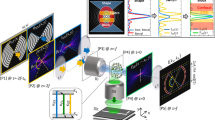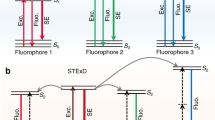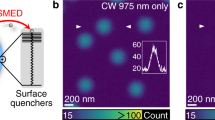Abstract
We report stimulated emission depletion (STED) fluorescence microscopy with continuous wave (CW) laser beams. Lateral fluorescence confinement from the scanning focal spot delivered a resolution of 29–60 nm in the focal plane, corresponding to a 5–8-fold improvement over the diffraction barrier. Axial spot confinement increased the axial resolution by 3.5-fold. We observed three-dimensional (3D) subdiffraction resolution in 3D image stacks. Viable for fluorophores with low triplet yield, the use of CW light sources greatly simplifies the implementation of this concept of far-field fluorescence nanoscopy.
This is a preview of subscription content, access via your institution
Access options
Subscribe to this journal
Receive 12 print issues and online access
$259.00 per year
only $21.58 per issue
Buy this article
- Purchase on Springer Link
- Instant access to full article PDF
Prices may be subject to local taxes which are calculated during checkout





Similar content being viewed by others
References
Abbe, E. Arch. Mikr. Anat. 9, 413–420 (1873).
Hell, S.W. & Wichmann, J. Opt. Lett. 19, 780–782 (1994).
Klar, T.A., Jakobs, S., Dyba, M., Egner, A. & Hell, S.W. Proc. Natl. Acad. Sci. USA 97, 8206–8210 (2000).
Willig, K.I., Rizzoli, S.O., Westphal, V., Jahn, R. & Hell, S.W. Nature 440, 935–939 (2006).
Donnert, G. et al. Proc. Natl. Acad. Sci. USA 103, 11440–11445 (2006).
Westphal, V. & Hell, S.W. Phys. Rev. Lett. 94, 143903 (2005).
Willig, K.I. et al. Nat. Methods 3, 721–723 (2006).
Lakowicz, J.R. Principles of Fluorescence Spectroscopy (Plenum Press, New York, 1983).
Yuan, A., Nixon, R.A. & Rao, M.V. Neurosci. Lett. 393, 264–268 (2006).
Sieber, J.J. et al. Science 317, 1072–1076 (2007).
Donnert, G., Eggeling, C. & Hell, S.W. Nat. Methods 4, 81–86 (2007).
Hopt, A. & Neher, E. Biophys. J. 80, 2029–2036 (2001).
Pawley, J.B. (ed.). Handbook of Biological Confocal Microscopy (Springer, New York, 2006).
Acknowledgements
We thank B. Hein for sharing the setup, T. Lang (Department of Neurobiology) for providing the PC12 membrane sheets, A. Schönle, V. Westphal and J. Keller for help with the measurement and analysis software, and B. Rankin for critical reading of the manuscript.
Author information
Authors and Affiliations
Corresponding author
Supplementary information
Supplementary Text and Figures
Supplementary Note (PDF 267 kb)
Rights and permissions
About this article
Cite this article
Willig, K., Harke, B., Medda, R. et al. STED microscopy with continuous wave beams. Nat Methods 4, 915–918 (2007). https://doi.org/10.1038/nmeth1108
Received:
Accepted:
Published:
Issue Date:
DOI: https://doi.org/10.1038/nmeth1108



